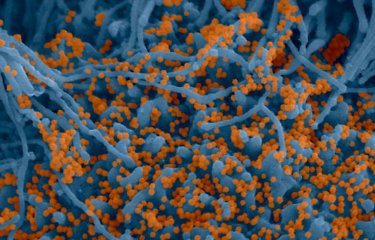-
Document de presse | 2023.12.05
COVID-19: the persistence of SARS-CoV-2 in the lungs and the role of innate immunity
One to two weeks after contracting COVID, the SARS-CoV-2 virus generally becomes undetectable in the upper respiratory tract. But does that mean that it is no longer present in the body? To find out, a team from the Institut Pasteur specialized in HIV, in collaboration with a French public research institute, the Alternative Energies and Atomic Energy Commission (CEA), conducted a study on lung...
-
Report | 2020.04.03
Coronavirus SARS-CoV-2: A look back at three months of mobilisation against an emerging disease (COVID-19)
On December 31, 2019, the WHO China Country Office was informed of cases of pneumonia of unknown etiology (unknown cause) detected in Wuhan City, Hubei Province of China. It was the official beginning of an epidemic that would rapidly become worldwide. In January, a task force was put in place at the Institut Pasteur and research projects were quickly launched. Here is a look back at three...
-
Article | 2020.06.22
Investigation of the first cases of coronavirus (COVID-19) infections and their contacts in Antananarivo, Madagascar
Aim: This study aims to understand the epidemiologic, clinical, virologic and immunologic characteristics of first infected cases, their evolution and household transmission. It is intended to follow confirmed infected cases and their household members. It will be conducted with clinicians from three hospital centers of Antananarivo.
-
Article | 2020.07.07
LuLISA project, bioluminescence as a tool for human diagnostics, from allergy to Covid19
LuLISA project, bioluminescence as a tool for human diagnostics, from allergy to Covid19
-
Article | 2020.07.07
CEPI collaborates with the Institut Pasteur in a consortium to develop Covid-19 vaccine
CEPI collaborates with the Institut Pasteur in a consortium to develop Covid-19 vaccine
-
Article | 2020.07.07
COVID-19: mathematical model indicates that between 3% and 7% of French people have been infected
COVID-19: mathematical model indicates that between 3% and 7% of French people have been infected
-
News | 2024.12.09
Lessons learned from the COVID-19 crisis: improving protection through early response, rapid tracking and impact monitoring
Scientific experts from 13 Western European countries have recently completed a review of key lessons learned from the way the COVID-19 pandemic was handled. Two key findings have emerged. Firstly, death rates were lower in countries that took measures early. Secondly, the need for a surveillance system capable of quickly tracking the community spread of a virus and its impact on hospitals was...
-
News | 2022.02.01
CoronaFISH: a new method for studying SARS-CoV-2 and detecting its presence in the body
The COVID-19 pandemic, which has afflicted the world for more than two years, is caused by SARS-CoV-2. The genome of this respiratory virus is composed of a single strand of RNA, a molecule similar to DNA that enables the virus to replicate in the body. Scientists from the Institut Pasteur, Inserm and the Paris Public Hospital Network (AP-HP) have developed a new method, CoronaFISH, to observe...
-
Article | 2020.06.16
The use of Artificial Intelligence Methods to Discriminate Covid-19 from other Community Acquired Pneumopathy using Chest X-Ray and CT images
Aim: Diagnostic of SARS-CoV-2 Coronavirus caused-disease (Covid-19) is a bottleneck in the immediate follow-up of patients. We propose automated detection methods based on Artificial Intelligence (AI) Algorithms (Machine Learning and Form Recognition), on chest Computed tomography (CT) or X-Ray images, to discriminate the Covid-19 disease from other Community Acquired Pneumonia (CAP). The methods...
-
Document de presse | 2020.11.03
Number of Covid-19 deaths in the under-65s: a more reliable indicator for assessing infection rates in populations
Simply comparing the total number of deaths across countries may provide a misleading representation of the underlying level of transmission of SARS-CoV-2, the virus that causes COVID-19, because of large differences in reported COVID-19 death rates in elderly populations in different countries.The research conducted by the University of Cambridge, the Institut Pasteur and the CNRS, published...

